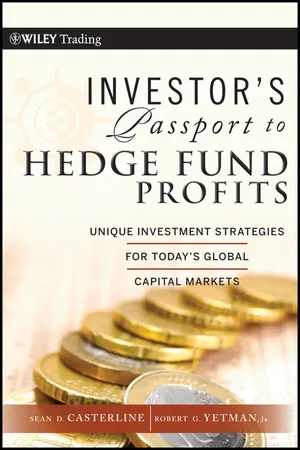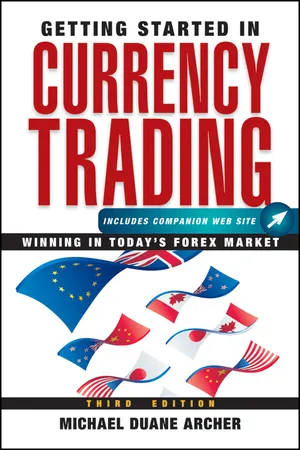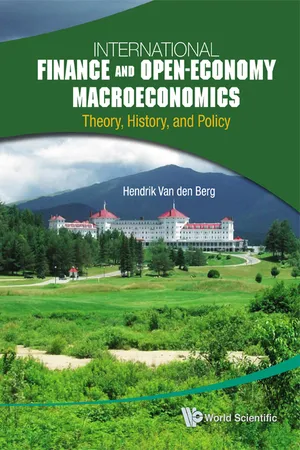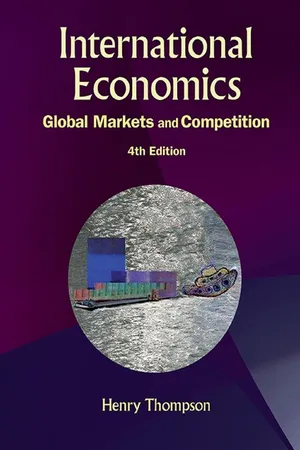Economics
Forex
Forex, short for foreign exchange, refers to the global marketplace for buying and selling currencies. It is a decentralized market where participants, such as banks, corporations, and individual traders, exchange one currency for another. Forex trading is essential for international trade and investment, as it allows businesses and investors to hedge against currency fluctuations and facilitate cross-border transactions.
Written by Perlego with AI-assistance
Related key terms
8 Key excerpts on "Forex"
- eBook - ePub
FX Trading
A Guide to Trading Foreign Exchange
- Alex Douglas, Larry Lovrencic, Peter Pontikis(Authors)
- 2011(Publication Date)
- Wiley(Publisher)
Chapter 2: What is foreign exchange?The abbreviations and words ‘FX’, ‘Forex’ and ‘foreign exchange’ are all interchangeable terms used to describe the market in which the currency of one country is exchanged for that of another country. Foreign exchange transactions may be as simple as those encountered by a tourist when visiting a local money changer to conduct a physical exchange of one currency for another, or as complex as multi-legged option strategies executed between global investment banks over electronic trading platforms with multiple settlement dates in multiple currencies. Each transaction forms a part of the foreign exchange market.An important concept to understand from the beginning is that, unlike the equities and futures markets, the foreign exchange market does not have a physical ‘exchange’ in which transactions are conducted. Nor is there a single electronic platform for the execution of FX trades. Foreign exchange is what is known as an ‘over-the-counter’ (OTC) market. In basic terms, this means that any two parties that come together and exchange currencies between one another on agreed terms are participating in the foreign exchange market. Unlike an ‘exchange-traded market’, like that which operates through the Australian Securities Exchange (ASX), with an OTC market there is no need for either party to report a trade to a central exchange, or for any other third party to ever know of the existence of the trade.While it is possible for every foreign exchange transaction to have a unique set of characteristics agreed to by each party, for the sake of simplicity and efficiency certain market conventions have emerged that allow for trading to take place within a framework of standard rules and conditions. These FX market conventions cover issues such as quoting methodology, terminology, and settlement dates and procedures. Because foreign exchange trading follows these conventions, we can view trades executed via many different methods as all forming a part of the one market. Don’t worry, we’ll get to explanations of the different methods of FX trading over the next few chapters. - eBook - ePub
Investor's Passport to Hedge Fund Profits
Unique Investment Strategies for Today's Global Capital Markets
- Sean D. Casterline, Robert G. Yetman(Authors)
- 2010(Publication Date)
- Wiley(Publisher)
For now, let us get our feet wet by looking more generally at the foreign exchange market. Foreign currency trading is exciting for all of us because it gives an investor the opportunity to trade in the world’s largest and most liquid market, the foreign currency market. An unbelievable $3.2 trillion changes hands on a daily basis and the foreign currency market moves exceptionally fast, with prices changing by the second. Outside of some indirect foreign central bank interference, no single event or institution can rule this market. It is truly “unmanipulatable” because of its sheer size, which assures investors that they are getting a fair shake. The first question we need to answer is, “What is the Forex market?” The foreign exchange market (or Forex) is one of the largest and most liquid financial markets in the world. It includes trading among large banks, central banks, corporations, governments, and traders like you and us. The foreign exchange market that we see today started evolving during the 1970s when, from all over the world, countries gradually switched to a floating exchange rate away from their fixed rates, as per the Bretton Woods system. As a refresher, the Bretton Woods Accord of 1944 was established to stabilize the global economy after World War II and is generally accepted as the original beginning of the foreign exchange market. It created the concept of trading currencies against each other and the International Monetary Fund (IMF). Currencies from around the world were fixed to the U.S. dollar, which in turn was fixed to gold prices in hopes of bringing stability to global foreign currency events. Central banks were allowed to revalue their currency in the face of certain “imbalances,” but other than that, the currencies all traded in a tight range - eBook - ePub
Getting Started in Currency Trading
Winning in Today's Market
- Michael D. Archer(Author)
- 2012(Publication Date)
- Wiley(Publisher)
Part 1 The Foreign Exchange MarketsPassage contains an image Chapter 1 The World of Forex Introduction—What Is Forex?
YOU ARE HERE—Before you can test the waters with a demo account, learning basic information about the Forex markets is essential. Part 1 will accomplish this task with discussions of history, terminology, and regulations.Foreign exchange is the simultaneous buying of one currency and selling of another. Currencies are traded through a broker or dealer and are executed in currency pairs, for example, the European Euro and the U.S. Dollar (EUR/USD) or the British Pound and the Japanese Yen (GBP/JPY). If you buy the GBP/JPY, you are long the GBP and short the JPY; if you sell the GBP/JPY, you are short the GBP and long the JPY. An account is typically funded with the currency of your resident country. A few Forex brokers offer the option of funding with a non-local currency.It is important to understand a Forex transaction is effectively a spread between two currencies. You cannot simply buy the USD or sell the JPY—the purchase or sale must be in relationship to another currency. This is one of two important facts to remember as we delve into the world of foreign exchange trading.The FOReign EXchange market (Forex) is the largest financial market in the world, with a turnover volume of $4 trillion daily. This is more than three times the total amount of the stocks and futures markets combined and almost a doubling in the past five years.Unlike other financial markets, the Forex spot market has neither a physical location nor a central exchange. It operates through an electronic network of banks, corporations, and individuals trading one currency against another. The lack of a physical exchange enables the Forex market to operate on a 24-hour basis, spanning all time zones across the major financial centers. This fact—that there is no centralized exchange—is the second important fact permeating all aspects of the Forex experience. - Homemade Loving's, Homemade Loving's(Authors)
- 2021(Publication Date)
- Books on Demand(Publisher)
An average income millionaire usually has between 7 and 10 different sources of income outside of his or her work income. One way of doing this is to build up a passive income in the world's largest market, the currency or Forex market, in the form of Forex.The following explanations in this book serve to present this field and its possibilities in detail and to show how a passive income can be built up in the world's largest market, the currency and foreign exchange market. First of all, it is a matter of explaining some of the terms used in Forex, so that even a beginner can become familiar with this subject.What is Forex and Forex trading?
The term Forex (short for Foreign Exchange Market) is the most common name for the foreign exchange or currency market today. Also the terms FX market, foreign exchange market or currency market are used colloquially. The Forex market is the most liquid and largest market in the world, which includes all the currencies existing in the world. In this market, the demand for foreign exchange meets the supply of foreign exchange and the exchange of foreign exchange takes place at the current exchange rate.There is no central marketplace where this foreign exchange trading is carried out, because the trade is mainly between the market participants.Forex trading is then understood to be the sale and purchase of foreign exchange or currencies. In doing so, investors try to profit from the exchange rate changes and thereby make a profit. In order to maximize the profit amount, very high financial levers are used. However, the use of high financial levers also means the risk of realizing high losses, which can far exceed the original investment.What is the foreign exchange or currency market?
The foreign exchange or currency market is the largest financial market in the world with a daily turnover of more than 5 trillion dollars. In contrast to the floor exchange, trading is possible here 5 days a week, 24 hours a day. Trading is usually possible practically from Sunday night until late Friday evening. Thus, trading is possible from Sunday to Friday non-stop without interruption.- eBook - ePub
Getting Started in Currency Trading
Winning in Today's Forex Market
- Michael D. Archer(Author)
- 2010(Publication Date)
- Wiley(Publisher)
I must reiterate: There is always some risk in speculation regardless of which financial instruments are traded and where they are traded, regulated or unregulated. Leverage is a door that swings both ways.Both stock and futures traders must make a similar adjustment to currency trading: In stocks and futures the specific investment vehicle is denominated in dollars or local currency. In Forex the underlying vehicle is a pair—the relative value of one currency to another.Summary
Forex means FOReign EXchange. The Forex (FX) market is more than a $4 trillion-a-day financial market, dwarfing everything else, including stocks and futures. Because there is no centralized exchange or clearinghouse for currency trading the Forex market is currently less regulated than other financial markets.There are a wide variety of reasons to consider Forex trading, including high leverage and low costs. Access to the Forex markets via the Internet has resulted in a great deal of interest by small traders previously locked out of this enormous marketplace. Getting started requires only this book, a review of the FX landscape, a computer and Internet connection, and a small grubstake.Passage contains an image
Chapter 2A Brief History of Currency TradingIntroduction
This material may not seem relevant to trading currencies today, but even a modest perspective adds substance and depth to a trader. “He who knows only his own generation remains always a child,” George Norlin once said.Ancient Times
Foreign exchange dealing can be traced back to the early stages of history, possibly beginning with the introduction of coinage by the ancient Egyptians, and the use of paper notes by the Babylonians. Certainly by biblical times, the Middle East saw a rudimentary international monetary system when the Roman gold coin aureus gained worldwide acceptance followed by the silver denarius - eBook - ePub
- Shani Shamah(Author)
- 2011(Publication Date)
- Wiley(Publisher)
The trade balance is a measure of the difference between imports and exports of tangible goods and services, and is a major indicator of foreign exchange trends. Seen in isolation, measures of imports and exports are important indicators of overall economic activity in the economy. Typically, a nation that runs a substantial trade balance deficit has a weak currency due to the continued commercial selling of the currency. This can, however, be offset by financial investment flows for extended periods of time.25.6 CONCLUDING REMARKSThe forces of supply and demand determine the value of currencies and there are, as mentioned before, two radically different methods of predicting where the forces of supply and demand are heading. The first method, fundamental analysis, focuses on macroeconomics. By studying economic reports and or political developments, fundamental analysts interpret changes in the underlying factors that cause foreign exchange rates to fluctuate. The other type of analysis, practised by technicians, primarily makes judgements based upon price data displayed on charts.Passage contains an image Chapter 26 Key Factors Impacting Currencies
On certain occasions, foreign exchange rates immediately reflect changes in economic conditions, while, on other occasions, the market adjusts only after a period of delay. In general, foreign currency traders will tend to focus on released information that will have an impact on the market within a matter of hours; this means that they will not hold very long positions as the odds of an unpredicted development effecting exchange rates increases with time. Therefore, to minimize market risk, traders tend to enter and exit the market quickly, while looking for ideas that, if sound, will produce short-term profits.The following is a guide to the essential fundamentals and practical factors impacting key foreign exchange rates against the dollar. 26.1 FACTORS AFFECTING THE YEN AGAINST THE DOLLARAsian markets and currencies generally move with the yen because Japan is the economic engine for the region. Economic problems, and/or political instability in particular countries, often affect Japanese companies and banks, which are heavily invested in the region, and therefore Asian instabilities undermine the yen. However, the major factors affecting the yen against the dollar are: - eBook - ePub
International Finance and Open-Economy Macroeconomics
Theory, History, and Policy
- Hendrik Van den Berg(Author)
- 2010(Publication Date)
- WSPC(Publisher)
Figure 3.5 also shows how volatile exchange rates have been over the past 25 years. As an average of individual exchange rates, an effective exchange rate should be less volatile than individual exchange rates. But notice that even the effective exchange rates of the US dollar have fluctuated widely, changing by more than ten percent in many years. The decline of the Major Currencies Index from nearly 150 to under 100 between early 1985 and the middle of 1986 stands out. Only a bit less surprising is the equally sharp increase in the effective value of the dollar during the first half of the 1980s.3.7 Summary and ConclusionsThis chapter introduces the foreign exchange rate, which is set in the foreign exchange market. This variable is one of the most important prices in our global economy, as it has a substantial long-run influence on the flows of payments between countries.Among the many points emphasized in the chapter are- The foreign exchange market is the largest financial market in the world; over $3.5 trillion in currencies are exchanged each working day.
- Foreign exchange markets have existed ever since money came into use and there was trade between regions with different moneys.
- In today's global economy, the foreign exchange market is characterized by several forms of arbitrage.
- The process of arbitrage, when carried out to its conclusion, equalizes prices across separate markets.
- This chapter detailed two specific forms of arbitrage in the foreign exchange market: geographic arbitrage and triangular arbitrage.
- Modern global communications have made geographic arbitrage nearly perfect, so that for each pair of currencies, the exchange rate is virtually identical in every financial center of the world.
- Triangular arbitrage means that all exchange rates are related to all others, and if the fundamental forces of supply and demand change one exchange rate, all others tend to change as well unless they are explicitly pegged or fixed.
- Triangular arbitrage also means that in a world of n different currencies, one only needs to know the exchange rates between one currency and the other n – 1 currencies to know all the [n(n – 1)]/2 cross rates.
- The true value of any one currency depends on its exchange rates with all other currencies, which is why economists often rely on effective exchange rates, which are weighted averages of exchange rates.
- eBook - ePub
International Economics
Global Markets and Competition
- Henry Thompson(Author)
- 2017(Publication Date)
- WSPC(Publisher)
Uncertainty about the exchange rate increases the risk of international transactions. A mechanism for avoiding exchange risk is the forward exchange market where a contract is signed to buy or sell foreign currency at some future date at a set rate.A. THE FOREIGN EXCHANGE MARKET
The FX market is based on the supply and demand of foreign exchange. Fundamental relationships involving exchange rates include •The exchange rate link to prices of imports and exports•The response of the BOT to depreciation or appreciationThe FX Market
An importer trades domestic currency for foreign currency on the foreign exchange FX market. Consider a US importer buying Japanese products. The importer can go through a bank to buy the yen to transfer to the bank of the Japanese exporter. Banks and import agencies specialize in currency transactions as well as import restrictions and customs paperwork.Suppose the exchange rate of the yen is $0.008 in the FX market. As with any commodity, price is expressed in home currency. Apples cost $1/pound and Japanese currency $0.008 per yen. One dollar trades for 1/.008 = 125 yen. If the price of M is 625 yen in dollars is $0.008 × 625 = $5. The decision of whether to import is based partly on the FX rate.If the price of the dollar rises to yen/$ = 200 the dollar price of M falls to 625/200 = $3.13. An appreciating currency lower the price of imports and increases the quantity demanded. If imports are elastic, import spending rises as does the quantity of foreign currency demanded.This inverse relationship between $/yen and the quantity of yen demanded is illustrated by the demand for yen in Figure 11.2 . The rise in yen/$ from 125 to 200 equals a fall in $/yen on the vertical axis from 0.008 to 0.005. The quantity of yen demanded rises from 20 to 30 trillion.On the supply side, Japanese importers buying US exports sell yen in the FX market. If the price of business services is $10/S
Index pages curate the most relevant extracts from our library of academic textbooks. They’ve been created using an in-house natural language model (NLM), each adding context and meaning to key research topics.







